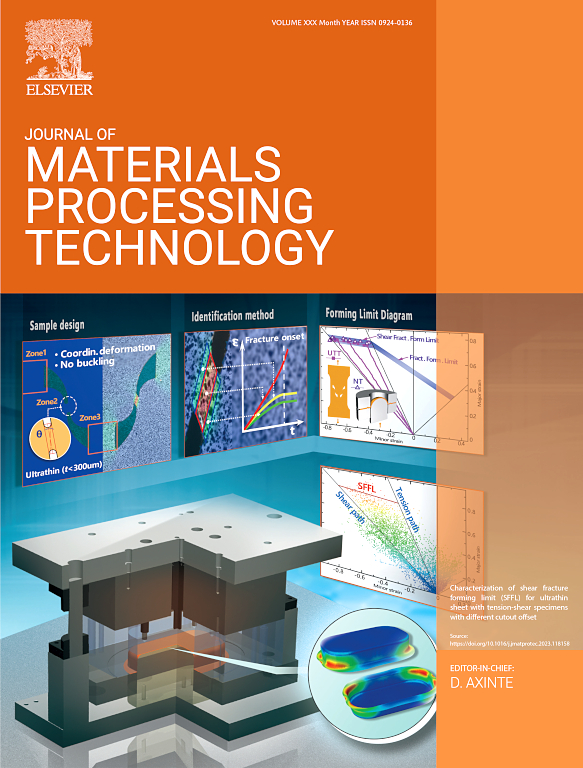A duplex surface modification method for increasing bending fatigue life of aviation carburized gear steel considering its mechanical properties and microstructure gradients
IF 6.7
2区 材料科学
Q1 ENGINEERING, INDUSTRIAL
Journal of Materials Processing Technology
Pub Date : 2025-03-19
DOI:10.1016/j.jmatprotec.2025.118812
引用次数: 0
Abstract
As an effective surface modification technology, laser shock peening can improve the fatigue performance of aerospace components. However, for gear components with complex configurations, this technology exhibits significant technical limitations such as difficulties in adhering absorbed layers and distortion of the laser spot due to the curvature at tooth roots. This paper innovatively introduces a method combining laser shock peening without coatings and vibratory polishing, aiming to enhance the bending fatigue performance of gear steel. Underlying mechanisms of bending fatigue resistance have been elucidated through the examination of mechanical properties, surface integrity, and microstructural evolution during modification. After LSP without coatings combined with vibratory polishing, a gradient structure of nanocrystals-fine grains was formed along the depth direction, with significant increases in dislocation density and types of dislocations. The mechanical properties of samples were improved by introducing a work hardening layer with thickness of 570 μm and a residual compressive stress layer with thickness of 510 μm. Adverse surface factors such as ablation and remelting morphologies were mitigated. Compared to as-received samples, bending fatigue limit was significantly increased by approximately 86.1 %. Fatigue resistance mechanisms can be attributed to combined effects of the second-phase strengthening mechanism caused by amorphous dispersed carbides, residual compressive stress, high-density dislocations, and interlocking structure coupled with nanotwins and intergranular dislocations. The duplex surface modification process integrates the advantages of the shockwave force effect induced by laser with the exceptional surface integrity achieved through vibration polishing, which renders impetus for the researchers striving for aerospace gear performance improvement.
考虑航空渗碳齿轮钢的力学性能和组织梯度,提高其弯曲疲劳寿命的双重表面改性方法
激光冲击强化作为一种有效的表面改性技术,可以改善航空航天部件的疲劳性能。然而,对于具有复杂配置的齿轮部件,该技术表现出显着的技术局限性,例如难以粘附吸收层和由于齿根曲率引起的激光光斑畸变。创新性地介绍了一种无涂层激光冲击强化与振动抛光相结合的方法,以提高齿轮钢的弯曲疲劳性能。通过对改性过程中力学性能、表面完整性和显微组织演变的检查,阐明了抗弯曲疲劳的潜在机制。无涂层LSP结合振动抛光后,沿深度方向形成纳米晶-细晶粒的梯度结构,位错密度和位错类型显著增加。通过引入厚度为570 μm的加工硬化层和厚度为510 μm的残余压应力层,提高了试样的力学性能。不利的表面因素,如烧蚀和重熔形貌减轻。与接收样品相比,弯曲疲劳极限显著提高约86.1 %。抗疲劳机制是由非晶分散碳化物、残余压应力、高密度位错、纳米孪晶和晶间位错联锁结构引起的第二相强化机制共同作用的结果。双相表面改性工艺将激光产生的冲击波力效应与振动抛光获得的优异表面完整性相结合,为研究人员努力提高航空齿轮的性能提供了动力。
本文章由计算机程序翻译,如有差异,请以英文原文为准。
求助全文
约1分钟内获得全文
求助全文
来源期刊

Journal of Materials Processing Technology
工程技术-材料科学:综合
CiteScore
12.60
自引率
4.80%
发文量
403
审稿时长
29 days
期刊介绍:
The Journal of Materials Processing Technology covers the processing techniques used in manufacturing components from metals and other materials. The journal aims to publish full research papers of original, significant and rigorous work and so to contribute to increased production efficiency and improved component performance.
Areas of interest to the journal include:
• Casting, forming and machining
• Additive processing and joining technologies
• The evolution of material properties under the specific conditions met in manufacturing processes
• Surface engineering when it relates specifically to a manufacturing process
• Design and behavior of equipment and tools.
 求助内容:
求助内容: 应助结果提醒方式:
应助结果提醒方式:


